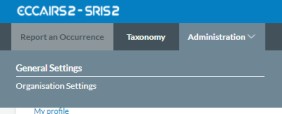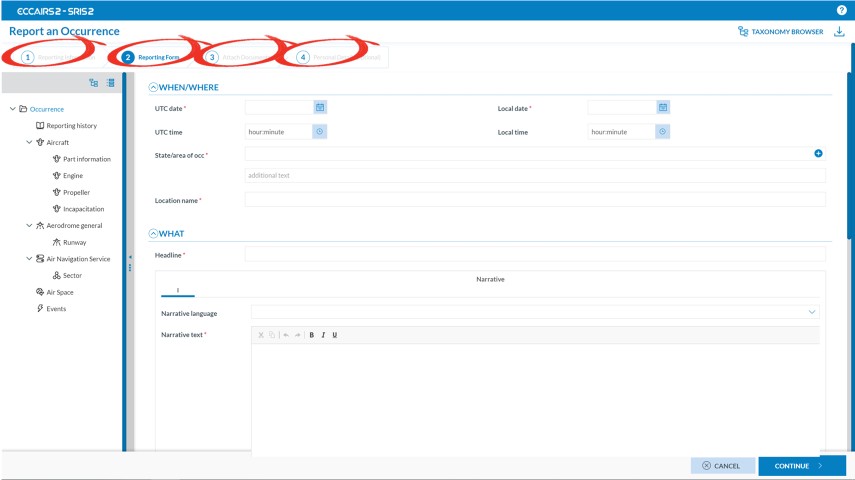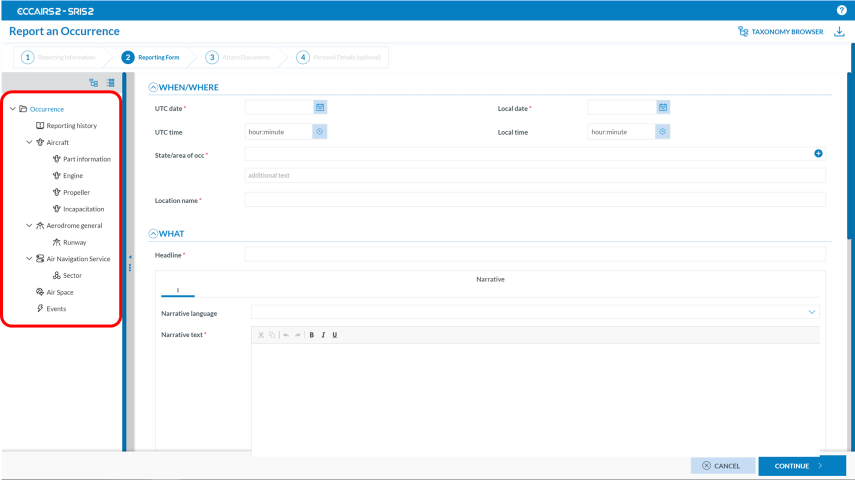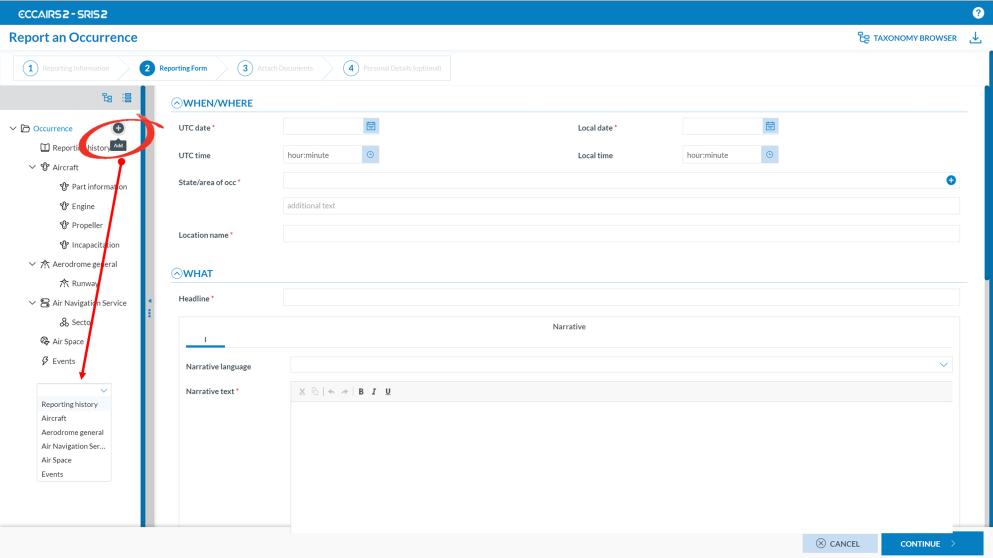Questions? Look here
Once logged. Home page is accessible by clicking on the ECCAIRS2-SRIS2 logo.
The landing page offers 3 tabs:
- Report an Occurence; where you will be able to select an Authority and go through the reporting process (online, offline, E5X upload)
- Taxonomy : allows reporters to connect to the online taxonomy browser, which provides information on the ADREP taxonomy.
- Administration : available only if user was set as administrator of your organisation, where the user management is done.
The home page gives an overview of all reports submitted as an individual reporter or by all users of the organisation the reporter belongs to.
Users will only be able to see the reports sent since the account creation. Previously submitted report are not available for technical/security reasons.
With a registered account, reporters can save their reports as drafts and continue their work later until submission. Users can also open already submitted reports, edit them and submit as update reports.
For Reporting Organisations Administrators, the user management takes place via the Administration tab, Organisation Settings submenu.

New users can be added or existing user can be updated (change role, update information, disable, delete)
When creating a new user, mandatory fields are Username and email address. The administrator also need to assign roles (reporter, administrator or both), once saved, the user account will then be created and he will get a notification.
The administrator can disable a user, also if a user has blocked his account (too many failed password attempts), the administrator will be able to see it and unblock it.
Taking into consideration feedbacks received from reporters, the navigation flow and the online reporting webforms available on the ECCAIRS 2 reporting portal were redesigned.
With this new design, it is much easier for reporters to identify at which stage of the reporting process they are thanks to the navigation flow bar displayed at the top level of the screen.
There are 4 stages on the reporting process, 1 is optional according to whether user is logged in or not.
- Reporting Information
- Reporting Form
- Attach Documents
- Personal Details (Optional)

On the reporting forms, the horizontal scrolling by page numbers which had its limitations was discarded and replaced by a vertical menu on the left side of the screen.
With this change, filling the report is much more efficient, users can now navigate more quickly to the different parts of the report by clicking directly on the different entities.

The new design also allows users to add multiple entities (for instance aircrafts), by clicking on the + icon next to the top occurrence level. Or by clicking on the duplicate button that will appear next to the

In next releases we will further improve the forms based on your feedback.
The now “old” reporting portal was part of the ECCAIRS Software Suite, developed maintained and operated by the Joint Research Centre (JRC) in Ispra, Italy, since 1989.
The JRC strategically decided to refocus its resources to its core mission, Research in the Scientific and Knowledge Management domains. The European Commission, represented by the DG Move, therefore, mandated the European Aviation Safety Agency (EASA) to take over the management of the ECCAIRS Software Suite.
An impact assessment and feasibility study were performed, and it resulted that taking over the ECCAIRS Software Suite “as is” was not the best option. The main reason is that the technology stack on which ECCAIRS was based was deemed too old and therefore difficult to maintain. A need was also expressed from the ECCAIRS community of users to work with a more current tool, with an improved user interface and leveraging on the newest technologies to be more performant. The decision was then taken to refactor completely the ECCAIRS Software Suite based on a more modern architecture, fully web-based.
Consequently, the ECCAIRS 2 programme, funded by the European Commission, was launched in January 2018, with the first phase which was focused on the functional analysis in collaboration with Key Users from representing the Civil Aviation Authorities and Safety Investigation Authorities from the EASA-Member States. The technical design followed-up and the technical development of the solution could finally start in September 2020.
The scope of the ECCAIRS 2 programme includes:
- the refactoring of the reporting portal, which brings new functionalities for the reporters
- the taxonomy browser where all stakeholders can consult the details of the latest version of the ADREP taxonomy
- the ECCAIRS 2 Web Application, where Competent Authority officers can process the reports received from the reporting portal and share them to the European Common Repository (ECR) following EU Reg 376/2014 requirements.
- A set of powerful API’s, allowing to (non-exhaustive):
- Connect external SMS systems to ECCAIRS 2, that could also be used for reporting;
- Connect analytical tools;
- Synchronize Value Lists in external system with the E2 Centrally Managed Taxonomy;
- the SRIS 2 Web Application, dedicated for the Safety Investigation Authorities, where they can enter and follow up Safety Recommendations addressed to aviation stakeholders
- the SRIS Public Portal, where Safety Recommendations, including their responses by the addressees, can be made available to the public.
Since the 5th of January, the new reporting portal has been released to the external world. There are some limitations during the transition/migration period of the Authorities to the new modules of ECCAIRS 2 which should be completed by end March 2021, these limitations are mainly related to the submission notifications sent to the reporters and the availability of features designed for registered reporters (see other specific item from the FAQ).
We are assessing solutions to improve the user experience on reporter’s side during the transition period.
There are also a set of known performance issues that are been working on with the highest priority such as loading time of the webforms. We are confident that the situation will stabilize on very short term and that reporters will soon benefit of the improved features E2 is offering.
Registered reporters can benefit of advanced functionalities such as :
- Accessing all the reports sent by them or their organization
- Perform some basic operations (print/navigate/export as PDF/…)
- Save draft versions of their report for later submission
- Edit/Enrich/Update already submitted reports as new information is available and send as update to the Authority.
The registered reporters will only be able to access those reports that were sent after their registration in the new aviation reporting portal.
Reporters that are not registered will still be invited to enter their email address at the end of the submission process.
By doing so, they will get a notification email confirming their submission which will include a link to the report that was submitted.
Using that link, they will still be able to perform the above mentioned operations but only of this individual report.
Individual reporters can self-register, they’ll have access to all the reports they sent individually.
Reporting Organisations need to request the creation of an “Organisational Account” to their Competent Authority.
To do so, they need to use the contact form (upper left corner of the E2 Central Hub), select their Competent Authority and specify "Request Access" as type of support that is required. In the request, they need to identify one user from their organisation that will act as an administrator for that Organisation Account. This administrator will manage the users from his own organisation.
The administrator of an organisation can assign 2 type of roles, "reporter" or "administrator".
All users with reporter role will have access to all the reports sent by them or other users of their organisation and are able to edit/update the reports sent.
The new reporting portal, at this stage, doesn’t support the latest version of the PDF’s you might have downloaded from the old reporting portal.
These latest version PDF’s were released in July 2020, and at that time the previous PDF’s where already developed and mapped to work with the new version of the reporting portal.
We have it in our backlog to upgrade the reporting portal to work with the newest version of the PDF’s as well, but until then the reporters should only use the versions of the PDF that can be downloaded from the new reporting portal.
Trying to upload any other version will fail.
The maximum length is currently set at 50 characters (filename + extension).
Depending on the complexity of the webforms that are being loaded and the size of the various underlying value lists that need to be cached in the browser, it can take quite some time for the reporting webforms to be displayed allowing input.
We are working with the project team to investigate if this can be improved.
The occurrence reporting databases of EASA, the Member States and organisations shall use formats which are:
(a) standardised to facilitate information exchange; and
(b) compatible with the ECCAIRS Software and the ADREP taxonomy.
The Key Principle from Guidance Material to Regulation (EU) 376/2014:
Occurrence reports contained in an organisation database and sent to the competent authority shall comply with format specifications that include the compatibility with the ECCAIRS Software and the ADREP Taxonomy, the use of standardised formats and the provision of mandatory data fields.
When occurrence reports are received at EASA and the Member States from both individuals and organisations they are entered into ECCAIRS compatible databases. Historically, this task involves manual data entry from paper forms into the electronic ECCAIRS system. However this is extremely time consuming and takes resources away from Safety Management. It also leads to reduce the quality of data in ECCAIRS databases that is used for analysis of safety. The main purpose of the Regulation is to use standard report and data transfer formats to reduce the level of manual data entry. Such standard reports and data transfer formats also help people across the European Aviation Community to report in the same way and use the same terminology.
The Accident Reporting System (ADREP) Taxonomy was originally developed by ICAO to standardise the reporting of accidents and incidents at global level. This taxonomy is used within the ECCAIRS system and is currently updated at European Level by the ECCAIRS Taxonomy WG that is chaired by EASA and supported at global level through the CAST/ ICAO Common Taxonomy Team. Because the taxonomy covers the full range of data collection needed for in-depth reports on aircraft accidents it has over 1200 data fields. However, many of these fields are not needed for occurrence reporting and therefore a smaller, reduced sub-set of the taxonomy is used for this purpose, this is called the Reduced Interface Taxonomy (RIT).